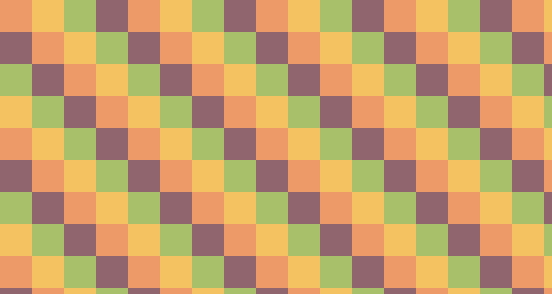Patterns

What is a Pattern?
A Pattern is a element in design and composition. Patterns in composition are images where the size, shape, position, symmetry, frequency, value, contrast, and colour are duplicated from a group of shape or objects. Patterns are used to draw attention to an area or create a comforting feel to a scene or piece. The reason why patterns are used is because the brain tries to make sense of what the eyes are seeing, forming and recognising patterns as they are easy to interpret. A pattern is usually defined by its repetition of a certain shape or form. These patterns can be found in nature through plants in a spiral pattern, through animals in a symmetry pattern and through other things such as ground, mountains, sand dunes etcetera.
Patterns are particularly useful in design and composition due to their ability to liven a scene or object up, making it much more appealing to look at which could in turn be the deciding factor of whether your design is appealing to look at or if its not.
Types of Patterns
Symmetry
A symmetry pattern is made from the mirror of an image. This can simply be the mirrored version of half an object to complete a full object similar to if you took an image of an animal down the middle vertically and mirrored it.
Spiral
A spiral pattern begins at a single point and moves away in a spinning motion. Sea shells are the most common example of this, but plants such as flowers show this pattern type well also.
Cracks
A crack pattern is a pattern that is created when an object's material is too stressed to hold together, causing it to separate and crack. These patterns are usually random and are never the same, and are most usually seen in ground formations such as volcanic rock and mud.
Waves and Dunes
Wave patterns occur when a object has a natural frequency or is disturbed causing resonance vibrations. This causes the water to smoothly rise and fall depending on it's frequency and physical properties. This is why when you drop an object in water, the water creates waves that will eventually settle. This same thing happens with dunes, especially with large open areas with sand as the wind is able to use it's natural frequency to move the sand over time.
Bubbles and Foam
Bubbles occur when a film is created from a liquid and has a constant average curve to it, meaning that it will form a sphere. This physical law is called Plateau's law, which requires films to have a constant average curvature to them.
Chaos and Meanders
Chaos and meander patterns are very random and are commonly referred to as 'noise', as they are random formations with no common structure to them. This ranges from vortexes like cloud formations etcetera. Chaos patterns are made of fractals as it is such a complex pattern.
Fractals
Fractals are never-ending patterns that are infinitely complex and are equal across scales, meaning that you can infinitely zoom into a fractal and it will only reveal smaller fractal patterns that are identical to the larger fractal. You can find many fractals in nature such as salt lakes, fern plants and leaves.
Spots and Stripes
Spot and stripes patterns consist of a either random or structured collection of spots or stripes spaced out. This type of pattern is common in nature, with animals such as reptiles and insects using them as a camouflage.
Tilings
Tiling patterns are patterns or images that are repeated side-by-side. These patterns don't occur in nature perfectly but are commonly used in construction and engineering as a simple way to make a scene look more appealing.
<what the photo is>
Tiling
<photo>
<what the photo is>
References:
- Wikipedia, "Pattern - Wikipedia." Accessed May 3rd 2017, https://en.wikipedia.org/wiki/Pattern
- Dominic Basulto, "Humans Are the World's Best Pattern-Recognition Machines, But for How Long?" Accessed May 3rd 2017, http://bigthink.com/endless-innovation/humans-are-the-worlds-best-pattern-recognition-machines-but-for-how-long
- Charlotte Jirousek, "Patterns." Accessed May 3rd 2017, http://char.txa.cornell.edu/language/element/pattern/pattern.htm
- Lucas Goehring, "Dynamics of crack patterns." Accessed May 3rd 2017, http://www.lgoehring.com/Crack_Patterns.html
- Physics Classroom, "Standing Wave Patterns." Accessed May 3rd 2017, http://www.physicsclassroom.com/class/sound/Lesson-4/Standing-Wave-Patterns
- Wikipedia, "Kármán Vortex Street - Wikipedia." Accessed May 4th 2017 https://en.wikipedia.org/wiki/K%C3%A1rm%C3%A1n_vortex_street
- Fractal Foundation, "What are Fractals? - Fractal Foundation." Accessed May 4th 2017 http://fractalfoundation.org/resources/what-are-fractals/
- Jess McNally, "Earth's Most Stunning Natural Fractal Patterns | WIRED." Accessed May 4th 2017 https://www.wired.com/2010/09/fractal-patterns-in-nature/